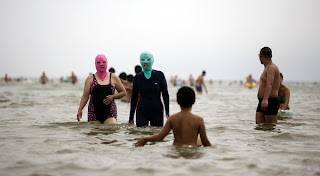Some of you have probably noticed the bizarre coincidence of a NYT article on Chinese women sporting neon balaclavas at the beach right in the middle of the Pussy Riot trial.
Pussy Riot have made brightly colored balaclavas their trademark. It seems that anyone donning such a mask can be in Pussy Riot, or at least show support. Madonna's was black, which I guess matched her outfit. It seemed to be the wrong note to me, as I'll explain below.
Balaclavas have been associated with violence for a long time. Balaclavas conceal the identity of the wearer, but also strike fear into opponents. The early Klan hoods pictured above conceal the wearers identities, protecting them from reprisal. The masks also seem intended to terrify, with large mustaches and other strange markings. It is impossible to tell from the image what color they were, but on the whole the outfits seem deliberately outlandish and garish. It would not be hard to imagine them brightly colored.
The image above of a Black September gunman at the Olympic Village in Munich is the defining moment of the balaclava as a symbol of fear. The balaclava is transcending its functional role and becoming purely symbolic. It represents a certain worldview, a certain philosophy that runs across a wide spectrum of post-1968 radicalism. The wearer is above responsibility to his community. The ends justify the means.
The balaclava was so connected with the militant left that it became part of the official "uniform" of many groups, like the IRA gunmen above. The well educated and media-savvy Subcomandante Marcos of the Zapatistas , on the right, made the woolen mask one of the first symbols of his movement, directly connecting it to post-68 radical groups.
Once something becomes so removed from its original function, it's easy for its symbolic meaning to be subverted or co-opted. This is certainly the case with the balaclava, which was co-opted by the elite state security units developed to combat the left-wing militants of the late 20th century. The mask is still used as a symbol of fear. It means all bets are off, you can forget about due process or your civil rights, the shit is going down and it is time to get out of here. Russian security forces routinely wear masks. The mask is totally disconnected from any leftist connotations and only represents extreme violence with impunity.
Enter Pussy Riot, who flip the symbol completely, breaking it out of the world of masculine political terror and creating a totally fresh set of associations. The rejection of militarized violence is indicated in the shift from black or olive drab to neon. In this case the mask is not a symbol of fear or intimdation, but exuberant energies that cannot be contained.
Then we have Chinese women at the beach. In a strange reversal of the Western standard, women in China try to stay pale to appear wealthy enough not to have to work outside. Women in the west of course use machines to make them darker. This is to appear wealthy enough to go on vacation.
In order to stay pale, many Chinese women have begun to wear neon balaclavas to the beach. At this point, we have reached the level of total semiotic absurdity that seems to me to be the defining characteristic of the 21st century.








VERY EDUCATIONAL!!!!!!!!
ReplyDelete